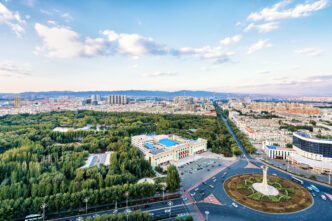A city in Eastern Germany, Chemnitz, has recently been named a European Capital of Culture, a designation that has surprised many due to the city’s challenges, including industrial decline, emigration, an aging population, and issues with right-wing extremism. Formerly known as Karl-Marx-Stadt during the GDR regime, Chemnitz is now seeking to highlight its strengths under the theme “C the unseen!”
The concept of a “Capital of Culture” originated in Greece 40 years ago, with the aim of preserving common cultural heritage. Initially, the title was awarded to cities rich in ancient culture, such as Athens, Paris, Amsterdam, and Florence. However, since Glasgow’s selection in 1990, the focus has shifted to include urban development, citizen participation, and cultural diversity. This change has encouraged cities facing economic and social challenges to apply for the title, which the European Union supports with funding to aid in their transformation.
Chemnitz, alongside Nova Gorica in Slovenia and Gorizia in Italy, has been chosen as a Capital of Culture for 2025. This opportunity has mobilized over a thousand volunteers, including Sophie and Cathleen, who are actively involved in the city’s initiatives. Despite some local skepticism, volunteers like Sophie believe in the potential for change through active participation.
With a third of its population over 60, Chemnitz is focusing on inclusive cultural projects. The “Dancing Neighbours” initiative, for example, aims to foster community engagement across different demographics. Project manager Alexandra Takats leads “Team Generation” to ensure that both long-time residents and newcomers can connect through socio-cultural projects.
In light of the 2018 riots, where right-wing extremist violence made headlines, Chemnitz remains a stronghold for the Eurosceptic party AfD, which holds a critical stance towards the Capital of Culture project. Nonetheless, the project’s organizers, like Pascal Anselmi, view active neighborhood involvement as a form of culture and democracy, encouraging residents to take an active role in their community.
Sociologist Ulf Bohmann from Chemnitz University of Technology supports this approach, suggesting that the Capital of Culture initiative can significantly impact the city’s social fabric, fostering democratic coexistence and resilience against extremism.
Among the key projects is “Living Neighbourhood,” which includes festivals and community-driven projects that empower residents to redesign their spaces creatively. The overarching goal is to engage with people closely, encouraging participation and cultural discovery in everyday life.
The Evolving Landscape
The designation of Chemnitz as a European Capital of Culture presents an opportunity for the city to redefine its identity and tackle longstanding social and economic challenges. By engaging citizens through cultural projects, Chemnitz aims to foster a sense of community and counteract the divisive influences of right-wing extremism. This initiative not only seeks to revitalize the city’s cultural landscape but also to promote social cohesion and democratic values.
For residents, the Capital of Culture status could mean a more vibrant urban environment with increased opportunities for community involvement and cultural exchange. The emphasis on inclusive projects may enhance the quality of life and encourage a more integrated and harmonious society. As Chemnitz embarks on this transformative journey, its success could serve as a model for other cities facing similar challenges, demonstrating the power of culture as a catalyst for positive change.








